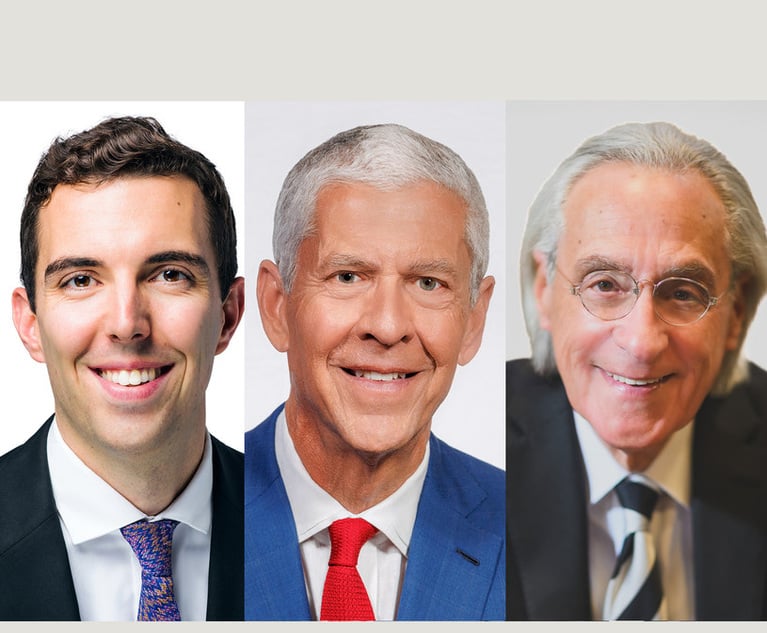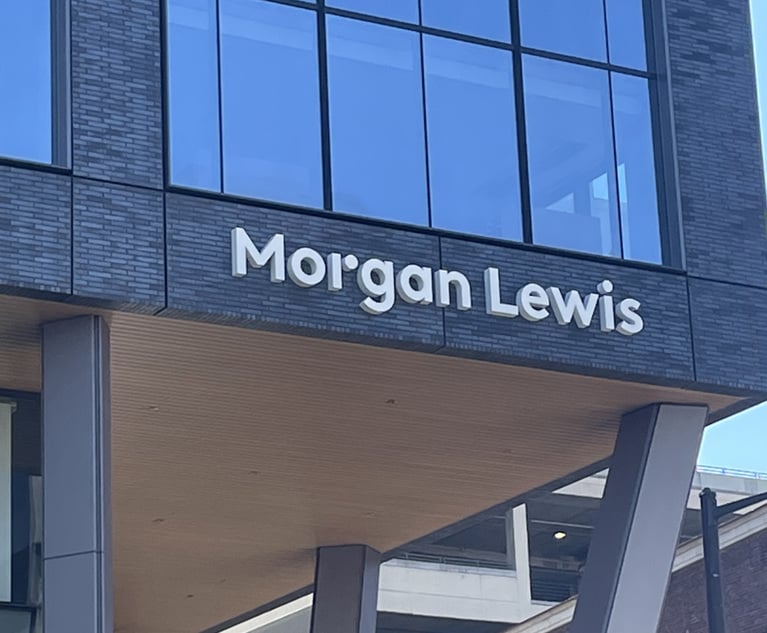Avoid the Search: Law Schools' Bar Pass Rates Now Found in One Spot
Not only has the ABA presented the data all together, but it shows that the vast majority of law graduates who take the bar exam pass within two years.
March 22, 2018 at 03:09 PM
3 minute read
New data from the American Bar Association provides bar pass rates at all ABA-accredited law schools, eliminating the need to search each school's sites for the information as well as bringing the numbers up to date.
The ABA's Section of Legal Education and Admissions to the Bar has taken a new approach to the disclosure of bar pass data this year. In the past, schools were required to report only their first-time bar pass rate to the ABA each fall, but that timing meant that the bar results were more than a year out of date by the time they were made public in the early winter. Hence, they were less helpful to prospective students choosing schools the following spring.
“These reports provide important consumer information for students considering whether and where to attend law school and for others with an interest in legal education,” said Barry Currier, the ABA's managing director of accreditation and legal education.
Separating out bar pass rates from the statistics that schools report in the fall, such as their enrollment numbers and tuition, means would-be law students have the most recent data available before plunking down a deposit.
Presenting individual school data on a single spreadsheet also provides an easy way to compare results between schools.
For example, the University of Chicago Law School; Yale Law School; and Duke Law School had the three highest first-time bar pass rates in 2017, at 98.12 percent, 97.65 percent, and 97.44 percent, respectively. (Marquette University Law School and the University of Wisconsin Law School are listed as having 100-percent pass rates, but that's because the states' diploma privilege allows graduates of those schools to join the bar without sitting for the exam.)
Conversely, Arizona Summit Law School; Thomas Jefferson School of Law; and Whittier Law School posted the lowest first-time pass rates in 2017, at 26.53 percent, 29.17 percent; and 35.26 percent respectively.
What's more, the newly released data shows that the vast majority of law graduates who take the bar exam pass within two years, even at a time when state pass rates have been trending down.
Nearly 88 percent of 2015 law grads who took the bar passed within two years, the ABA found. Additionally, 77 percent of the 2017 law grads who took the bar passed on their first try, as did 74 percent of 2016 grads nationwide.
Reporting the two-year “ultimate bar pass rate” measure is yet another change designed to give prospective students a realistic picture of how a school's graduates fare on the all-important licensing exam. In addition to first-time passers, that statistic captures those who passed the exam on the second or third tries.
The ABA data also shows how each school's bar pass rate compares to the statewide pass rate for the jurisdiction in which the school's largest cohort of student took the exam. That statistic helps identify which schools over perform and underperform on the bar exam compared to their in-state counterparts.
This content has been archived. It is available through our partners, LexisNexis® and Bloomberg Law.
To view this content, please continue to their sites.
Not a Lexis Subscriber?
Subscribe Now
Not a Bloomberg Law Subscriber?
Subscribe Now
NOT FOR REPRINT
© 2025 ALM Global, LLC, All Rights Reserved. Request academic re-use from www.copyright.com. All other uses, submit a request to [email protected]. For more information visit Asset & Logo Licensing.
You Might Like
View All
The Right Amount?: Federal Judge Weighs $1.8M Attorney Fee Request with Strip Club's $15K Award

Kline & Specter and Bosworth Resolve Post-Settlement Fighting Ahead of Courtroom Showdown
6 minute read
12-Partner Team 'Surprises' Atlanta Firm’s Leaders With Exit to Launch New Reed Smith Office
4 minute read
Morgan Lewis Shutters Shenzhen Office Less Than Two Years After Launch
Trending Stories
- 1Courts Demonstrate Growing Willingness to Sanction Courtroom Misuse of AI
- 2The New Rules of AI: Part 1—Managing Risk
- 3Change Is Coming to the EEOC—But Not Overnight
- 4Med Mal Defense Win Stands as State Appeals Court Rejects Arguments Over Blocked Cross-Examination
- 5Rejecting 'Blind Adherence to Outdated Precedent,’ US Judge Goes His Own Way on Attorney Fees
Who Got The Work
J. Brugh Lower of Gibbons has entered an appearance for industrial equipment supplier Devco Corporation in a pending trademark infringement lawsuit. The suit, accusing the defendant of selling knock-off Graco products, was filed Dec. 18 in New Jersey District Court by Rivkin Radler on behalf of Graco Inc. and Graco Minnesota. The case, assigned to U.S. District Judge Zahid N. Quraishi, is 3:24-cv-11294, Graco Inc. et al v. Devco Corporation.
Who Got The Work
Rebecca Maller-Stein and Kent A. Yalowitz of Arnold & Porter Kaye Scholer have entered their appearances for Hanaco Venture Capital and its executives, Lior Prosor and David Frankel, in a pending securities lawsuit. The action, filed on Dec. 24 in New York Southern District Court by Zell, Aron & Co. on behalf of Goldeneye Advisors, accuses the defendants of negligently and fraudulently managing the plaintiff's $1 million investment. The case, assigned to U.S. District Judge Vernon S. Broderick, is 1:24-cv-09918, Goldeneye Advisors, LLC v. Hanaco Venture Capital, Ltd. et al.
Who Got The Work
Attorneys from A&O Shearman has stepped in as defense counsel for Toronto-Dominion Bank and other defendants in a pending securities class action. The suit, filed Dec. 11 in New York Southern District Court by Bleichmar Fonti & Auld, accuses the defendants of concealing the bank's 'pervasive' deficiencies in regards to its compliance with the Bank Secrecy Act and the quality of its anti-money laundering controls. The case, assigned to U.S. District Judge Arun Subramanian, is 1:24-cv-09445, Gonzalez v. The Toronto-Dominion Bank et al.
Who Got The Work
Crown Castle International, a Pennsylvania company providing shared communications infrastructure, has turned to Luke D. Wolf of Gordon Rees Scully Mansukhani to fend off a pending breach-of-contract lawsuit. The court action, filed Nov. 25 in Michigan Eastern District Court by Hooper Hathaway PC on behalf of The Town Residences LLC, accuses Crown Castle of failing to transfer approximately $30,000 in utility payments from T-Mobile in breach of a roof-top lease and assignment agreement. The case, assigned to U.S. District Judge Susan K. Declercq, is 2:24-cv-13131, The Town Residences LLC v. T-Mobile US, Inc. et al.
Who Got The Work
Wilfred P. Coronato and Daniel M. Schwartz of McCarter & English have stepped in as defense counsel to Electrolux Home Products Inc. in a pending product liability lawsuit. The court action, filed Nov. 26 in New York Eastern District Court by Poulos Lopiccolo PC and Nagel Rice LLP on behalf of David Stern, alleges that the defendant's refrigerators’ drawers and shelving repeatedly break and fall apart within months after purchase. The case, assigned to U.S. District Judge Joan M. Azrack, is 2:24-cv-08204, Stern v. Electrolux Home Products, Inc.
Featured Firms
Law Offices of Gary Martin Hays & Associates, P.C.
(470) 294-1674
Law Offices of Mark E. Salomone
(857) 444-6468
Smith & Hassler
(713) 739-1250









